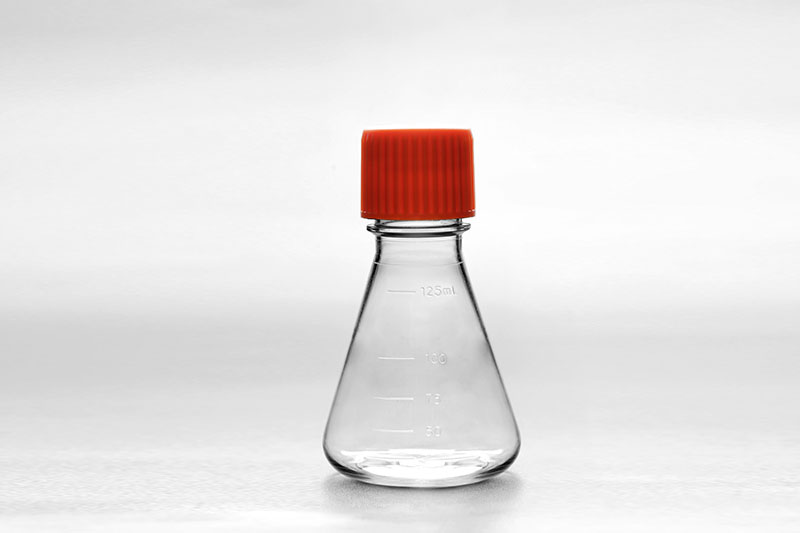재료 및 방법
3.1. Shake Flask Cultivations
MDCK.SUS2 현탁 세포의 사전 배양물을 세포는 화학적으로 정의된 무단백질 및 동물 성분이 없는 배지인 Smif8(Smif8 PGD 2x, 5mM 글루타민 및 8이 보충된 500mL 진탕 플라스크(#4113-0500, Nalgene™, Thermo Scientific, Waltham, MA, USA) 초기 배양 부피는 150rpm에서 200mL입니다. 세포가 약 200시간 동안 성장하는 모의 감염(배양 1)과 접종 후 약 49시간에 세포가 IAV로 감염되는 감염(배양 2)의 두 가지 배양이 수행되었습니다. 세포 집단의 동시 감염을 달성하기 위해 moi = 10이 사용되었습니다. 감염 시 상대적으로 낮은 세포 농도(2.1 × 106 cells/mL)와 높은 moi 사용으로 인해 배지 교체나 트립신 추가(바이러스 활성화를 위해)가 필요하지 않았습니다. 두 배양 모두에서 실험이 수화되지 않은 인큐베이터에서 수행되었기 때문에 수분 증발(1-2mL/일)을 보상하기 위해 샘플링 전에 멸균 Milli-Q 물을 추가했습니다.(125mL 폴리카보네이트 삼각 플라스크, #431143, Corning®, New York City, NY, USA)에서 50mL 작업 부피(wv)로 성장시켰습니다. , 37°C 및 5% CO2 대기에서 Multitron Pro 인큐베이터(Infors HT, Bottmingen, Switzerland)에서 180rpm의 진동 빈도로. 세포는 0.5–0.8 × 106 cells/mL의 파종 밀도로 3–4일마다 계대되었습니다. 부착성 MDCK 세포(ECACC # 84121903). 종자 바이러스의 역가는 1.1 × 109 TCID50/mL입니다.
출처:
https:/ /www.mdpi.com/2218-1989/12/3/239/htm
Growth and infection experiments for model validation were performed using 500 mL shaking flasks (#4113-0500, Nalgene™, Thermo Scientific, Waltham, MA, USA) with an initial cultivation volume of 200 mL at 150 rpm. Two cultivations were performed, one mock-infection (Cultivation 1), where cells grew for about 200 h, and one infection (Cultivation 2), where cells were infected with IAV at about 49 h post inoculation. To achieve a synchronous infection of the cell population, a moi = 10 was used. Due to the relatively low cell concentration at time of infection (2.1 × 106 cells/mL) and the high moi used, neither medium replacement nor trypsin addition (for virus activation) was necessary. In both cultivations, sterile Milli-Q water was added before sampling to compensate for water evaporation (1–2 mL/day) since the experiment was performed in a non-hydrated incubator.
Source from: https://www.mdpi.com/2218-1989/12/3/239/htm
The FAI climbed 5.9 percent year-on-year in the first 11 months of 2018, quickening from the 5.7-percent growth in Jan-Oct, the National Bureau of Statistics (NBS) said Friday in an online statement.
The key indicator of investment, dubbed a major growth driver, hit the bottom in August and has since started to rebound steadily.
In the face of emerging economic challenges home and abroad, China has stepped up efforts to stabilize investment, in particular rolling out measures to motivate private investors and channel funds into infrastructure.
Friday's data showed private investment, accounting for more than 60 percent of the total FAI, expanded by a brisk 8.7 percent.
NBS spokesperson Mao Shengyong said funds into weak economic links registered rapid increases as investment in environmental protection and agriculture jumped 42 percent and 12.5 percent respectively, much faster than the average.
In breakdown, investment in high-tech and equipment manufacturing remained vigorous with 16.1-percent and 11.6-percent increases respectively in the first 11 months. Infrastructure investment gained 3.7 percent, staying flat. Investment in property development rose 9.7 percent, also unchanged.
 English
English



















































